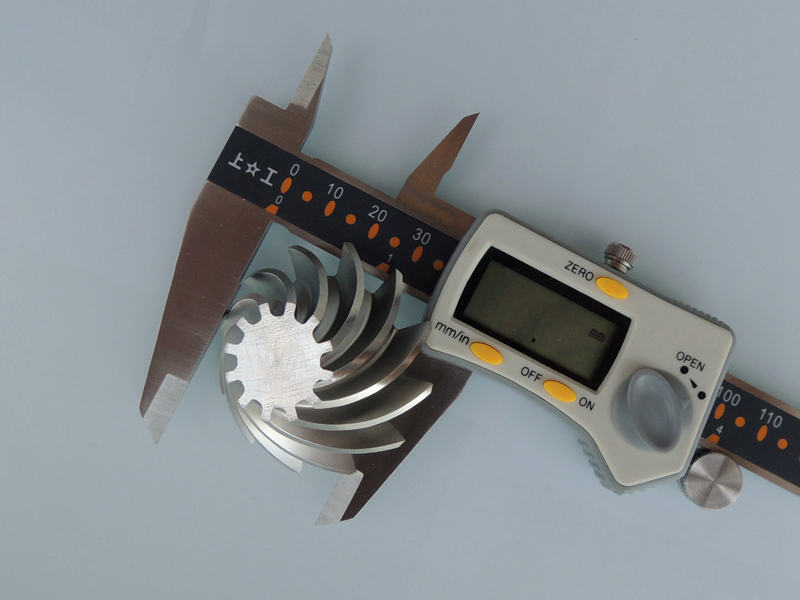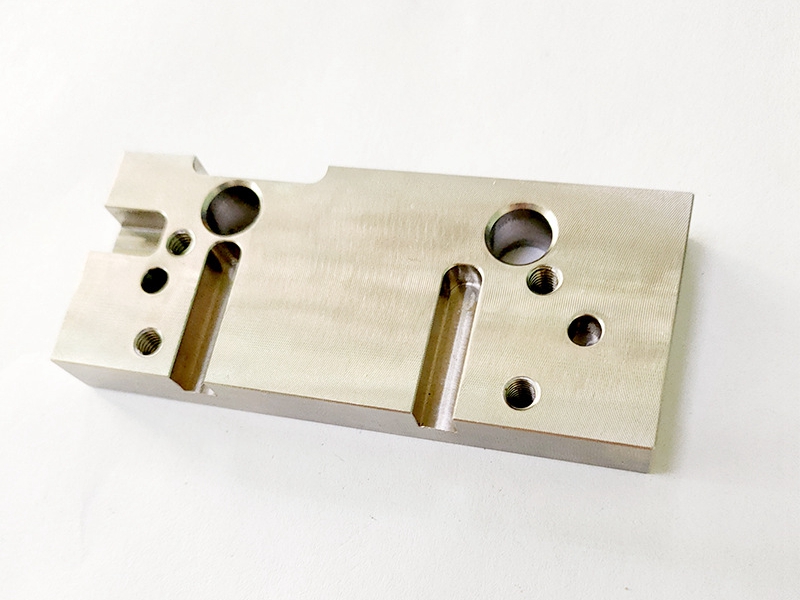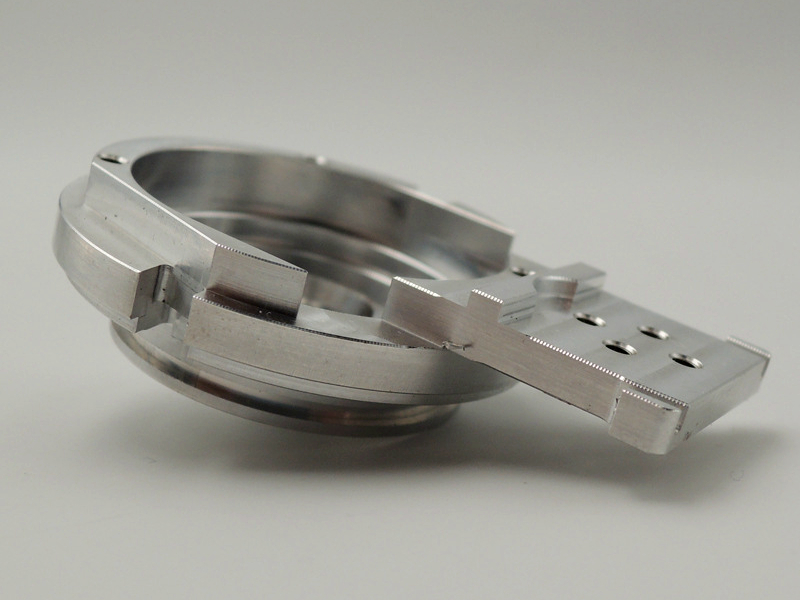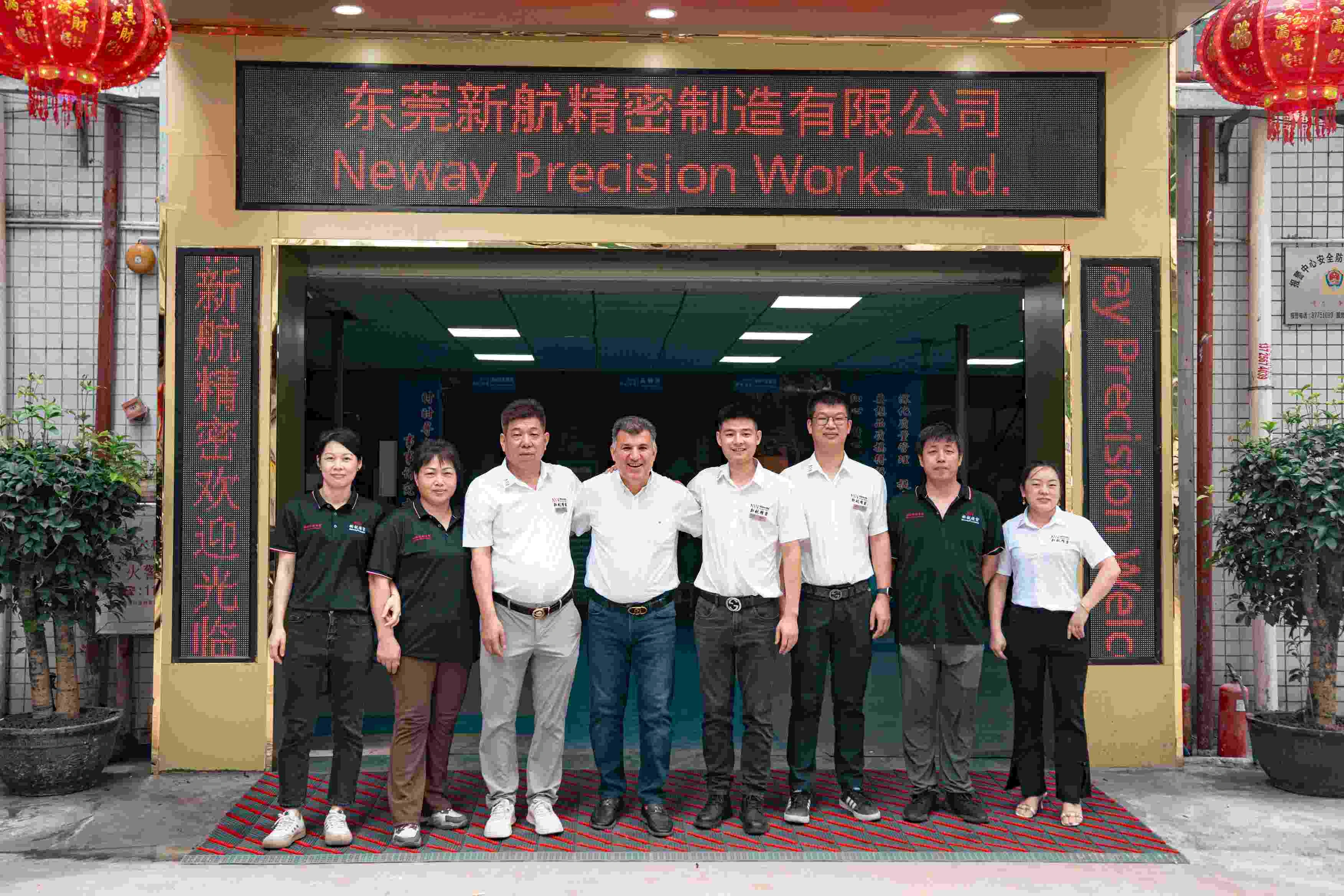أجزاء CNC مفرّزة من الألمنيوم والصلب حسب الطلب – احصل على عرض سعر
تُعتبَر الأجزاء المفرزة باستخدام ماكينات التفريز CNC عنصرًا أساسيًا في إنتاج المكوّنات عالية الدقة ذات الأشكال الهندسية المعقدة والتحمّلات الضيقة. ومن خلال الاستفادة من تقنيات التصنيع الطرحي مثل التفريز ثلاثي المحاور وخماسي المحاور (3-Axis & 5-Axis)، يمكن للمصنّعين تحقيق دقة أبعادية متناهية في مجموعة واسعة من التطبيقات.
تدعم خدمات التفريز باستخدام ماكينات CNC من Neway إنتاج الأجزاء المخصّصة من الألمنيوم والفولاذ، الموجّهة لقطاعات الطيران، والطب، والطاقة، وإلكترونيات المستهلك. سواء كان الهدف هو النماذج الأولية أو الإنتاج على نطاق كامل، فإننا نقدّم مكوّنات مفرزة عالية الجودة مع قابلية تكرار متّسقة وسرعة في التنفيذ.
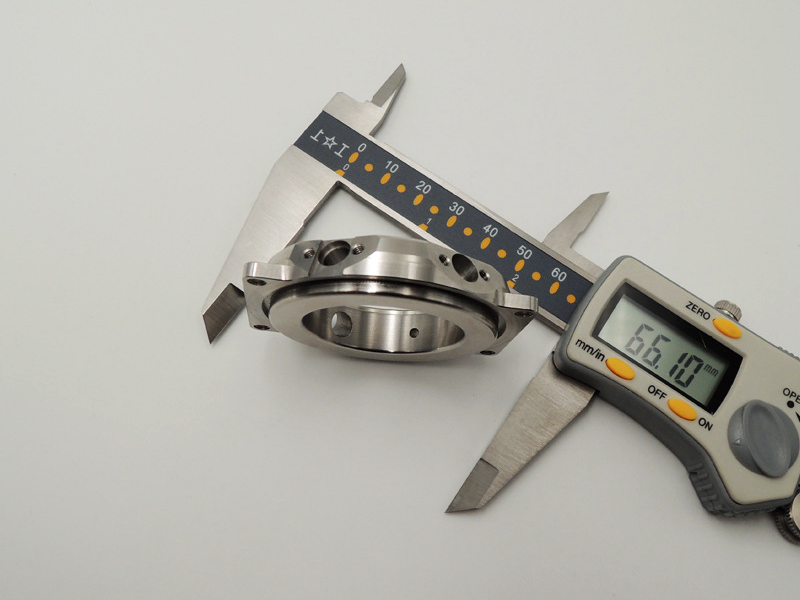
رؤى حول المواد: الألمنيوم مقابل الفولاذ في الأجزاء المفرزة باستخدام CNC
يُعد اختيار المادة المناسبة عاملًا حاسمًا في تحسين أداء الجزء وتكلفته وكفاءة تصنيعه. وبفضل خصائصهما الفيزيائية والميكانيكية المختلفة، يُعتبَر الألمنيوم والفولاذ الخيارين الأكثر شيوعًا للأجزاء المخصّصة المفرزة باستخدام CNC.
تفريز الألمنيوم باستخدام CNC
يقدّم الألمنيوم قابلية تشغيل ممتازة، ومقاومة للتآكل، ونسبة عالية من القوة إلى الوزن. وتُستخدم الدرجات الشائعة مثل 6061 و7075 و5052 على نطاق واسع في هياكل الطائرات، وهياكل الإلكترونيات، وتجميعات السيارات. كما أن التوصيلية الحرارية والاستقرار الأبعادي للألمنيوم يجعلان منه مادة مثالية للتشغيل عالي السرعة والتطبيقات ذات التحمّلات الضيقة.
تُستخدَم تطبيقات مثل مكوّنات هياكل الطائرات، وهياكل الأجهزة المنزلية، والحوامل الدقيقة كثيرًا في تشغيل الألمنيوم باستخدام CNC نظرًا لخفّة وزن المادة وسهولة تشكيلها.
تفريز الفولاذ باستخدام CNC
يُفضَّل الفولاذ عندما تكون هناك حاجة إلى قوة عالية، ومقاومة للاهتراء، وتحمل حراري جيد. تُعتبَر الفوالذ الكربونية مثل 1018 و1045 و4140 مناسبة للمكوّنات الهيكلية والأجزاء الحاملة للأحمال. بينما توفّر الفوالذ المقاومة للصدأ مثل 304 و316L مقاومة ممتازة للتآكل في البيئات الطبية والبحرية.
تشمل حالات الاستخدام كتل المحرّكات، ودعائم الحفر، وهياكل الماكينات. ويُعتبَر كلٌّ من تشغيل الفولاذ الكربوني باستخدام CNC و تشغيل الفولاذ المقاوم للصدأ باستخدام CNC أمرين أساسيين في الصناعات التي تُعطي الأولوية للمتانة الميكانيكية وطول عمر المكوّنات.
تطبيقات صناعية للأجزاء المفرزة من الألمنيوم والفولاذ باستخدام CNC
تلعب الأجزاء المخصّصة المفرزة باستخدام CNC دورًا حيويًا في القطاعات التي تتطلّب تحمّلات ضيقة، وقابلية تكرار متّسقة، وأداءً محدّدًا وفق المادة المستخدمة. سواء تم اختيار الألمنيوم أو الفولاذ، تمتلك كل صناعة متطلباتها التقنية الخاصة وحالات الاستخدام اليومية.
قطاع الطيران
يجب أن تكون مكوّنات الطيران خفيفة الوزن وقادرة في الوقت نفسه على تحمّل الإجهاد الميكانيكي ودورات الحرارة المتكرّرة. غالبًا ما يُختار الألمنيوم لشفرات التوربينات، ودرع الحرارة، وأجزاء الهيكل بفضل نسبة القوة إلى الوزن العالية ومقاومة التآكل. أما الفولاذ فيُخصَّص لحوامل المحرّك ونقاط الربط الهيكلية التي تتطلّب متانة أعلى.
توليد الطاقة
تُعتبَر الأجزاء المفرزة بدقة جزءًا لا يتجزّأ من توربينات الغاز، ومبادلات الحرارة، والحشوات عالية الحرارة. يُستخدَم الألمنيوم في الحوافظ الحرارية غير الحاملة للأحمال، بينما يُعد الفولاذ ضروريًا للدعائم الحاملة والحواظز المقاومة للحرارة. تضمن المكوّنات المخصّصة المصنعة عبر خدمات التفريز باستخدام CNC سلامة بنيوية واستقرارًا حراريًا في ظروف التشغيل الديناميكية.
النفط والغاز
يتطلّب هذا القطاع مواد قادرة على تحمّل الضغط العالي، والتآكل، والاهتراء الكاشط. تُستخدَم الأجزاء الفولاذية المفرزة باستخدام CNC على نطاق واسع، بما في ذلك أجسام الصمامات، وحوافظ لقّم الحفر، وحوامل المنصّات. وغالبًا ما تُطبَّق درجات الفولاذ المقاوم للصدأ للحماية من التآكل في البيئات البحرية.
المنتجات الاستهلاكية
في الإلكترونيات والأجهزة المنزلية، يوفّر الألمنيوم مظهرًا جماليًا وقابلية تشغيل ممتازة. تُنتج هياكل الأجهزة المنزلية، وهياكل الإلكترونيات، وأدوات المطبخ المخصّصة غالبًا باستخدام التشغيل متعدد المحاور للحصول على منحنيات معقدة وتشطيبات أنيقة.
الأجهزة الطبية
يُستخدَم كلٌّ من الألمنيوم والفولاذ المقاوم للصدأ على نطاق واسع في الأدوات الجراحية، وزرعات العظام، والمعدات السنيّة. تتطلّب هذه الأجزاء أشكالًا دقيقة، وتشطيبات سطحية ناعمة، والامتثال لتحمّلات مخصّصة للتطبيقات الطبية. وغالبًا ما تُستكمَل الأجزاء المشغولة بطلاءات PVD أو التلميع الكهربائي لتلبية معايير النظافة.
الآلات الزراعية
يتطلّب هذا المجال مكوّنات متينة ومقاومة للاهتراء مثل الوصلات، والألواح المقاومة للتآكل، وهياكل الماكينات. تُفضَّل الأجزاء الفولاذية الكربونية المفرزة لما تتمتّع به من قوة ميكانيكية. بينما يُستخدَم الألمنيوم بشكل انتقائي لتقليل الوزن البنيوي في التجميعات المتحركة.
قطاع السيارات
تستفيد مكوّنات مثل كتل المحرّكات، والشواحن التوربينية، وملاقط المكابح، وأجزاء الشاسيه من التفريز باستخدام الألمنيوم والفولاذ على حدٍّ سواء. يُستخدَم الألمنيوم في أجزاء الأداء الخفيفة، بينما يظل الفولاذ أساسيًا في الهياكل المقاومة للصدمات وعناصر نظام نقل الحركة. تُظهر حلول التشغيل في قطاع السيارات لدينا كيف يعزّز اختيار المادة الأداء والكفاءة.
الروبوتات
تُصنَّع الأذرع الروبوتية الدقيقة، والوصلات، وحوافظ المشغِّلات باستخدام الألمنيوم والفولاذ. يوفّر الألمنيوم سهولة الحركة والتحكّم الحراري، بينما يضمن الفولاذ متانة الوصلات تحت الأحمال. يتيح التفريز باستخدام CNC إنشاء أسطح تلامس عالية التحمّل، وهي ضرورية لأنظمة الحركة الآلية.
الأتمتة
يجب أن تحافظ لوحات التحكّم، والحوامل، وحوافظ الحساسات، والأجزاء الهيكلية في خطوط الأتمتة على الاستقرار والدقة. يوفّر الألمنيوم سرعة تشغيل ممتازة وعزلًا كهربائيًا جيدًا، بينما يمنح الفولاذ قوة تثبيت ومقاومة للصدمات.
المعدات الصناعية
تعتمد حوافظ المضخّات، وعلب التروس، والحوافظ الميكانيكية في هذه الفئة على مقاومة الفولاذ للاهتراء ومقاومة السبائك المقاومة للصدأ للتآكل. ويُستخدَم الألمنيوم في الأغطية خفيفة الوزن ومكوّنات تخميد الاهتزاز.
الطاقة النووية
تُعد الدقة أمرًا بالغ الأهمية في هذا القطاع عالي الحساسية. تشمل الأجزاء المفرزة مكوّنات المفاعل، وأدلة قضبان الوقود، ودرع الحرارة. ولا يُسمح إلا بفئات محدّدة من الفولاذ والسبائك المقاومة للتآكل. وغالبًا ما تُطبَّق المعالجات السطحية مثل التخميل للمحافظة على عمر الخدمة وتقليل مخاطر التلوّث.
خيارات التشطيب السطحي والمعالجة اللاحقة
غالبًا ما تحتاج الأجزاء المفرزة من الألمنيوم والفولاذ باستخدام CNC إلى تحسينات سطحية لتلبية المتطلبات الميكانيكية أو الحرارية أو الجمالية. تعمل المعالجات اللاحقة على تحسين المظهر وتؤثر في مقاومة التآكل، والدقة الأبعادية، والأداء الوظيفي.
تشطيبات الأجزاء المصنوعة من الألمنيوم
يستجيب الألمنيوم جيدًا لمجموعة واسعة من المعالجات السطحية. تشمل الخيارات الشائعة:
الأنودة (Anodizing): تعزّز مقاومة التآكل، وتحسّن الصلادة، وتوفّر خيارات لونية متعددة. مثالية لإلكترونيات المستهلك، والحوامل في قطاع الطيران، ودرع الحرارة. لمزيد من التفاصيل، راجع الأنودة لأجزاء الألمنيوم المشغولة باستخدام CNC.
السفع الرملي (Sandblasting): يُستخدَم لتحضير الأجزاء للطلاء أو للحصول على نسيج مطفي. غالبًا ما يُطبَّق قبل الطلاء بالمسحوق أو الرش.
الطلاء بالمسحوق (Powder Coating): يوفّر طبقة حماية سميكة، متجانسة، ومقاومة للصدمات. يُستخدَم في تطبيقات السيارات والأجهزة المنزلية. تعرّف أكثر على الطلاء بالمسحوق لأجزاء CNC.
التلميع والبرش (Polishing & Brushing): يعزّزان المظهر البصري للمنتجات الاستهلاكية والتجميعات الدقيقة. اطّلع على كيفية تطبيق تقنيات البرش لتحقيق التشطيبات الساتان والمطفي على الألمنيوم.
تشطيبات الأجزاء المصنوعة من الفولاذ
غالبًا ما تحتاج الأجزاء الفولاذية المشغولة باستخدام CNC إلى طلاءات أو معالجات توفّر مقاومة للاهتراء، وحماية من التآكل، وسلامة بنيوية. تشمل الطرق الشائعة:
الطبقة السوداء (Black Oxide): تُطبَّق على الأجزاء الفولاذية الكربونية لتوفير طبقة خفيفة من مقاومة التآكل ومظهر داكن مميّز. شائعة في مكوّنات الأتمتة والأدوات. اكتشف المزيد عن طبقة Black Oxide للأجزاء الفولاذية المشغولة باستخدام CNC.
التلميع الكهربائي (Electropolishing): يُستخدَم كثيرًا مع الفولاذ المقاوم للصدأ لتنعيم السطح وتعزيز مقاومة التآكل. شائع في التطبيقات الطبية والغذائية. طالع كيف يحسّن التلميع الكهربائي نعومة ومتانة أجزاء CNC.
الفوسفاتة (Phosphating): توفّر مقاومة للاهتراء وتساعد على التصاق الدهان للأجزاء المستخدمة في قطاعات النفط والغاز أو الزراعة. راجع دور الفوسفاتة في تعزيز متانة أجزاء CNC.
الطلاء بالكروم (Chrome Plating): يوفّر سطحًا شديد الصلادة ومقاومًا للاهتراء للأجزاء ذات التلامس الديناميكي مثل التروس والأعمدة. تجد التفاصيل في دليل الطلاء بالكروم لأجزاء CNC.
المعالجة الحرارية (Heat Treatment): تُغيّر البنية المجهرية للفولاذ لتحسين الصلادة، وقوة الإجهاد، والمتانة. تُجرى عادةً قبل أو بعد التشغيل. اكتشف كيف تعزّز المعالجة الحرارية قوة أجزاء CNC.
من خلال اختيار التشطيب المناسب حسب المادة والوظيفة، يمكن للأجزاء المفرزة باستخدام CNC تحقيق عمر خدمة أطول وموثوقية ميكانيكية فائقة.
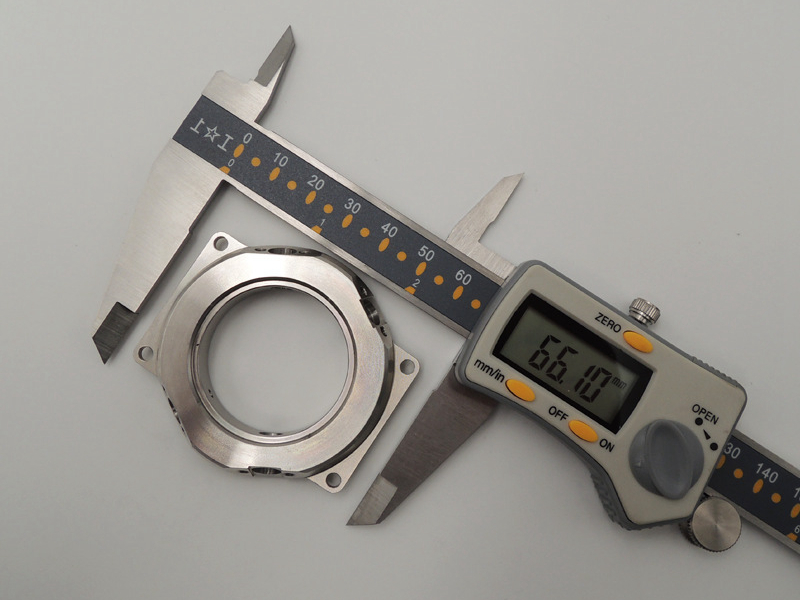
التصميم للتصنيع (DFM): إرشادات للأجزاء المخصّصة المفرزة باستخدام CNC
تبدأ الأجزاء المخصّصة الناجحة المفرزة باستخدام CNC بقرارات تصميم تتوافق مع قدرات التصنيع وخصائص المواد. يساهم التصميم للتصنيع (DFM) في تقليل زمن الإنتاج والتكلفة، مع تحسين أداء الجزء واتّساق جودته.
الهندسة المثلى والتحمّلات
يُظهِر كلٌّ من الألمنيوم والفولاذ سلوكًا مختلفًا تحت قوى القطع. يسمح الألمنيوم بمعدلات تغذية أعلى وسرعات دوران أكبر، بينما يتطلّب الفولاذ تشغيلًا أبطأ وأكثر تحكّمًا للحفاظ على الدقة الأبعادية. لتحسين التصميم:
الحفاظ على سماكة جدار متجانسة: تجنّب الكتلة الزائدة أو الجدران الرقيقة التي قد تؤدي إلى الاهتزاز أو الرنين أثناء التشغيل.
تحديد تحمّلات قابلة للتحقيق: تحمّل عام ±0.1 مم اقتصادي لمعظم التطبيقات. يمكن تحقيق تحمّلات أكثر تشددًا مثل ±0.01 مم لكن ذلك يزيد التكلفة. الشرح الكامل متاح في مقال فهم تحمّلات التشغيل: ما يجب على المشترين معرفته قبل طلب أجزاء CNC.
تقليل عدد التجاويف العميقة والجيوب المعقدة: تتطلّب هذه الميزات أدوات خاصة أو إعدادات متعددة المحاور، مما قد يطيل زمن التسليم.
إمكانية الوصول إلى الميزات
تحتاج أدوات التفريز إلى وصول غير معوَّق إلى جميع الميزات. ولتحقيق قطع فعّال:
وجّه الأجزاء بحيث تكون معظم الميزات قابلة للوصول من مستوى واحد.
تجنّب التجاويف العميقة ذات نسب الطول إلى القطر العالية؛ استخدم الأضلاع أو أشكال التدرُّج بدلاً من ذلك.
ضع في الاعتبار تأثير قطر الأداة على أنصاف الأقطار الداخلية للزوايا — يجب أن يكون نصف القطر الأدنى ≥ نصف قطر الأداة.
تقليل تغييرات الأدوات وعدد الإعدادات
يساهم التصميم باستخدام مقاسات أدوات قياسية وعدد أقل من العمليات في خفض تعقيد التشغيل:
حاذِ الثقوب والفتحات في مستوى واحد قدر الإمكان.
تجنّب سماكات المواد المتعدّدة التي تتطلّب تغييرات متكرّرة في طول الأداة.
استخدم الشطب (Chamfers) بدلاً من الزوايا المدوّرة (Fillets) عندما لا تكون القوة عاملًا حرجًا.
للمزيد من رؤى DFM، يتناول دليل القواعد الذهبية العشر لـ DFM في تشغيل CNC أفضل الممارسات لتقليل إعادة العمل، والتكلفة، والتأخير.
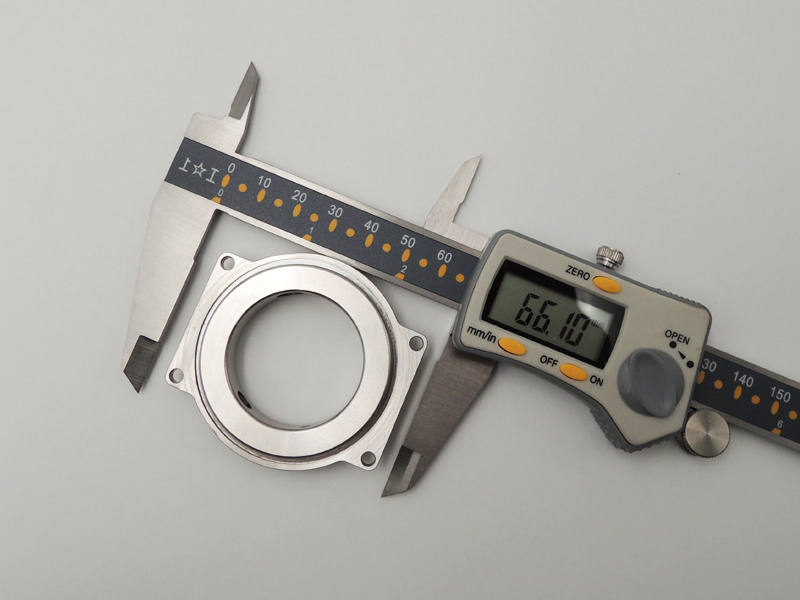
التطبيقات الشائعة حسب الصناعة للأجزاء المفرزة من الألمنيوم والفولاذ باستخدام CNC
يتيح التفريز المخصّص باستخدام CNC إنتاج مكوّنات عالية الدقة ومصمَّمة للتطبيق عبر صناعات متعدّدة. يُستخدَم كلٌّ من الألمنيوم والفولاذ على نطاق واسع بحسب متطلبات الأداء الوظيفي.
الصناعة | أجزاء الألمنيوم الشائعة | أجزاء الفولاذ الشائعة |
|---|---|---|
الطيران | مكوّنات الهيكل، الحوامل، دروع الحرارة | حوامل المحرّك، الوصلات الهيكلية |
توليد الطاقة | شفرات مراوح خفيفة، هياكل مبادلات الحرارة | حشوات التوربينات، حوافظ الدعم |
النفط والغاز | لوحات العدّادات، ألواح تثبيت خفيفة الوزن | أجسام الصمامات، دعائم الحفر المقاومة للتآكل |
المنتجات الاستهلاكية | هياكل الإلكترونيات، ألواح الأجهزة المنزلية | أدوات المائدة، المكوّنات الميكانيكية عالية الاهتراء |
الأجهزة الطبية | زرعات عظمية، حواضن سنيّة | أدوات جراحية، حوافظ معقّمة |
القطاع الزراعي | هياكل حوافظ، أغطية الماكينات | هياكل الشاسيه، وصلات مقاومة للاهتراء |
السيارات | مكوّنات المكابح، حوامل لوحة العدّادات | كتل المحرّك، أجزاء نظام التعليق |
الروبوتات | أذرع روبوتية خفيفة، ألواح دقيقة | تروس، مشغِّلات حركة |
الأتمتة | حوافظ الحساسات، ألواح وحدات التحكّم | حوامل الدعم، أذرع القفل |
المعدات الصناعية | حوافظ، قواعد تثبيت | مضخّات، هياكل أدوات مقاومة للحرارة |
الطاقة النووية | ألواح بنيوية خفيفة الوزن | أوعية ضغط، أجزاء محمية من الإشعاع |
للاطلاع على تطبيقات فعلية، تفقّد التشغيل متعدد المحاور والتشطيب بالأنودة لمفاصل روبوتية من ألمنيوم 6061، أو حلول الخراطة والجَلْخ باستخدام CNC لأعمدة فولاذية 4140 لا مركزية في ضواغط هواء سيارات.
تُبرِز هذه الأمثلة كيف يؤثّر اختيار المادة وسياق التطبيق في استراتيجية التفريز المعتمدة.
الفحص وضبط الجودة في الأجزاء المفرزة باستخدام CNC
لا يقتصر تحقيق الدقة في الأجزاء المفرزة باستخدام CNC على التصميم والتشغيل فحسب، بل يتطلّب أيضًا ضمان مطابقة الأبعاد، وسلامة المادة، وموثوقية الأداء من خلال نظم صارمة لضبط الجودة.
الدقة الأبعادية: ماكينات القياس الإحداثية (CMM)
توفّر ماكينات القياس الإحداثية فحصًا على مستوى أجزاء الميكرون للمكوّنات عالية الدقة، خاصة في قطاعي الطيران والطب. فهي تتحقّق من الأبعاد الحرجة مثل التسطيح، والتعامد، والتراكز، بما يضمن التزام الأجزاء بمواصفات GD&T.
تقدّم CMM قابلية تكرار تصل إلى ±0.001 مم.
مثالية للتحقق من الأشكال الهندسية المعقدة وتراكب التحمّلات.
مفيدة لفحص القطع الأولى (FAI) والتحكّم في دفعات الإنتاج النهائية.
تقييم التشطيب السطحي
بحسب المتطلبات الوظيفية، قد يتراوح خشونة السطح (Ra) بين 3.2 ميكرومتر للأجزاء البنيوية و0.8 ميكرومتر أو أقل لأسطح الإحكام. تشمل الطرق الشائعة للتحقق من التشطيب السطحي:
استخدام أجهزة القياس الخطّي (Profilometers) لتتبّع وقياس نسيج السطح.
الفحص البصري للتحقّق من المعايير الجمالية في المكوّنات الموجّهة للمستهلك.
يمكنك معرفة المزيد عن خيارات التشطيب المختلفة في دليل تشطيبات أسطح أجزاء CNC: من التنعيم الأساسي إلى الطلاءات المتخصّصة.
فحص المواد والعيوب
بالنسبة للتطبيقات الحرجة:
يكشف الفحص بالأشعة السينية والاختبار بالموجات فوق الصوتية عن الفجوات الداخلية والشوائب.
تقيّم المجهرية المعدنية (Metallographic Microscopy) سلامة البنية المجهرية.
بالنسبة للفوالذ، يؤكد اختبار الصلادة فعالية المعالجة الحرارية.
على مدونة Neway، يمكنك التعرّف على طرق الاختبار بالموجات فوق الصوتية وغيرها من تقنيات الاختبار غير الإتلافي.
يضمن هذا النهج متعدّد الطبقات في الفحص أن يلبّي كل جزء يتم شحنه المواصفات المطلوبة، خاصة في الصناعات الخاضعة للوائح صارمة.
